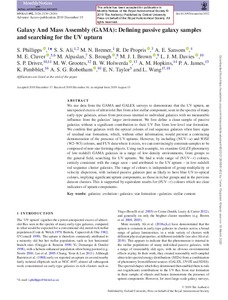Galaxy And Mass Assembly (GAMA): Defining passive galaxy samples and searching for the UV upturn
S Phillipps; S S Ali; M N Bremer; R De Propris; A E Sansom; M E Cluver; M Alpaslan; S Brough; M J I Brown; L J M Davies; S P Driver; M W Grootes; B W Holwerda; A M Hopkins; P A James; K Pimbblet; A S G Robotham; E N Taylor; L Wang
Galaxy And Mass Assembly (GAMA): Defining passive galaxy samples and searching for the UV upturn
S Phillipps
S S Ali
M N Bremer
R De Propris
A E Sansom
M E Cluver
M Alpaslan
S Brough
M J I Brown
L J M Davies
S P Driver
M W Grootes
B W Holwerda
A M Hopkins
P A James
K Pimbblet
A S G Robotham
E N Taylor
L Wang
OXFORD UNIV PRESS
Julkaisun pysyvä osoite on:
https://urn.fi/URN:NBN:fi-fe2021042826233
https://urn.fi/URN:NBN:fi-fe2021042826233
Tiivistelmä
We use data from the GAMA and GALEX surveys to demonstrate that the UV upturn, an unexpected excess of ultraviolet flux from a hot stellar component, seen in the spectra of many early-type galaxies, arises from processes internal to individual galaxies with no measurable influence from the galaxies' larger environment. We first define a clean sample of passive galaxies without a significant contribution to their UV flux from low-level star formation. We confirm that galaxies with the optical colours of red sequence galaxies often have signs of residual star formation, which, without other information, would prevent a convincing demonstration of the presence of UV upturns. However, by including (NUV-u) and WISE (W2-W3) colours, and FUV data where it exists, we can convincingly constrain samples to be composed of non-star-forming objects. Using such a sample, we examine GALEX photometry of low-redshift GAMA galaxies in a range of low-density environments, from groups to the general field, searching for UV upturns. We find a wide range of (NUV-r) colours, entirely consistent with the range seen - and attributed to the UV upturn - in low-redshift red sequence cluster galaxies. The range of colours is independent of group multiplicity or velocity dispersion, with isolated passive galaxies just as likely to have blue UV-to-optical colours, implying significant upturn components, as those in richer groups and in the previous data on clusters. This is supported by equivalent results for (FUV-r) colours which are clear indicators of upturn components.
Kokoelmat
- Rinnakkaistallenteet [27094]
